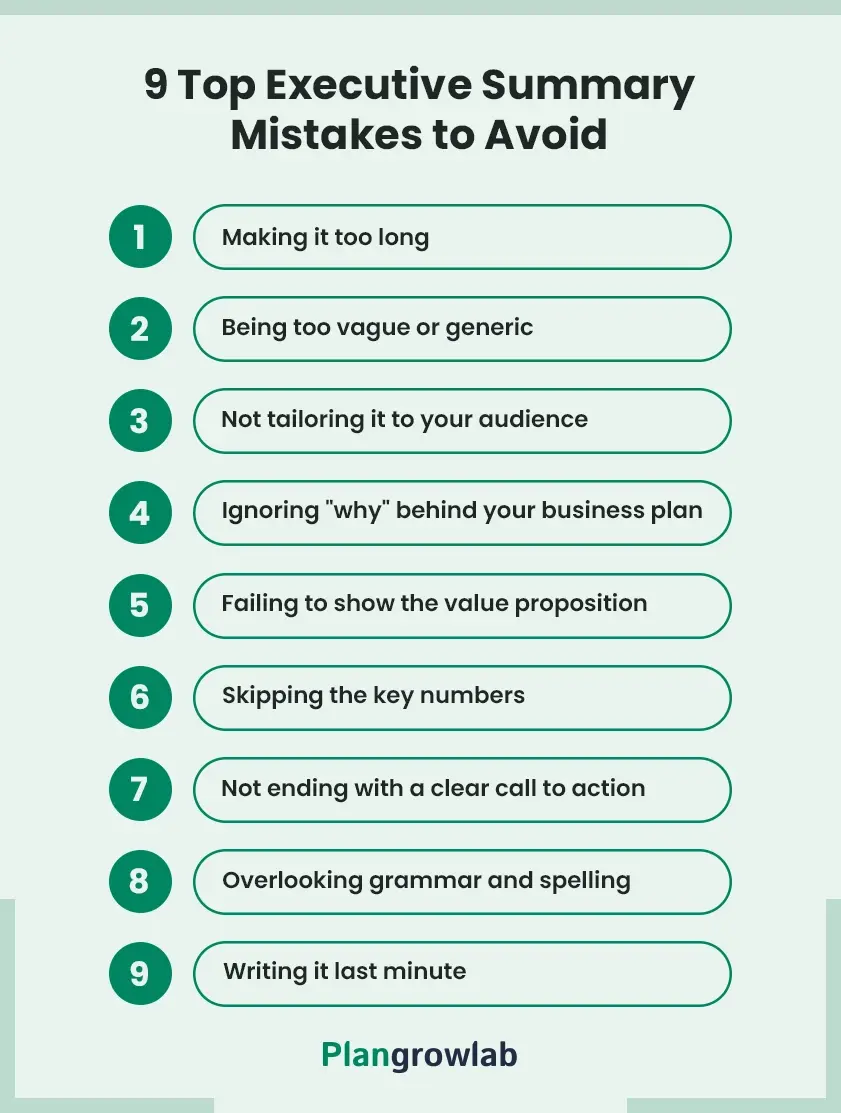If there’s one part of the business plan that founders often get wrong on the first try, it’s the executive summary. Too vague, too long, too salesy, or just plain confusing—we’ve seen it all.
This is the section that’s supposed to open strong and pull the reader in. But because it comes first, most people either overthink it or rush through it.
I've reviewed hundreds of executive summaries over the years. The pattern is clear: when it’s done well, the rest of the plan gets read. When it’s weak, the reader rarely makes it to page two.
I’ve fixed enough broken summaries to know exactly what mistakes cost you attention and what to do instead.
In this article, I’ll walk through the most common executive summary mistakes, the fixes that work, and how we coach founders to write summaries that actually land.
9 Top executive summary mistakes to avoid
I said I reviewed 100+ business plans and executive summaries, but it doesn’t mean I came across hundreds of mistakes, too. The fun fact is—most entrepreneurs make similar mistakes.
So, I’ve compiled a list of 9 most common mistakes that I came across over the years. Here we go:

1) Making it too long
An executive summary is meant to provide a snapshot of your business, giving the reader a clear and concise overview.
However, this practice can work against you if you add too much information and make it overly lengthy.
When a reader is looking for a quick summary, presenting them with a detailed, drawn-out version of your business plan can feel overwhelming and tedious. As a result, they may lose interest and not proceed to read the full plan.
We often see founders trying to impress with volume instead of clarity. One founder sent a five-page summary once, thinking more would look serious. You know what happened? The investor didn’t even open the second page.
To avoid such a situation:
- Keep it short and to the point (1-2 pages max).
- Focus on the highlights: Your business idea, market potential, and key financials.
- Save the finer details for the main business plan.
- Once you’ve drafted the summary, review it to eliminate redundancies and trim excess content.
- Share your summary with someone unfamiliar with your business. If they grasp the key points quickly, you’re on the right track.
We always run this test in our consulting projects: can someone skim the summary in 60 seconds and get the business? If not, it’s back to editing.
2) Being too vague or generic
Being too vague or generic means failing to clearly explain what your business does, how it stands out in the market, or what specific problem it solves.
Instead of showcasing your unique value, vague statements like "We provide innovative solutions" offer little context or detail. What solutions? How are they innovative? Without specifics, such phrases confuse readers and fail to differentiate your business.
I’ve seen plans where the executive summary could apply to five different industries. If your summary sounds like it could belong to any company, it’s a red flag. Investors and lenders want to know exactly what you do.
To avoid this, be precise and descriptive. Highlight exactly what you do, who you serve, and the impact your solutions create.
Phrases like "We're a leader in our industry" or "Our product is the best" also lack substance and don't offer any real proof or differentiation.
This lack of clarity can leave the reader confused about your business and its value.
Whenever we rewrite executive summaries for clients, one of our first questions is, “What’s the one thing only you do this way?” If you can’t answer that clearly, the summary won’t land.
Let’s take an eco-friendly cleaning product manufacturing company that will help you understand how to avoid such mistakes:
| Mistake | Right Approach |
|---|---|
| Using vague, generic phrases like "We offer great solutions." | "We offer eco-friendly cleaning products that reduce harmful chemicals by 50%." |
| Saying "Our company is a leader in the industry" without proof. | "We’re the only company in the region offering biodegradable cleaning products certified by Green Seal." |
| Stating "We provide innovative technology" without explaining the specifics. | "Our patented technology reduces energy consumption in industrial machines by 20%." |
| Claiming "Our service is unmatched" without context or evidence. | "Our service has a 98% customer satisfaction rate, supported by 1,000+ verified reviews." |
| Using phrases like "cutting-edge" or "revolutionary" without clarity. | "Our product uses a unique algorithm that increases data processing speed by 40% compared to industry standards." |
3) Not tailoring it to your audience
Imagine you walk into a market to buy clothes. The large sign outside the store clearly indicates it's a clothing store, so you feel excited about finding a new outfit.
However, once you step inside, you're surprised to find it's a restaurant instead. How would that make you feel? Confused, right?
This is exactly what can happen if your executive summary is not tailored to your audience.
Just like you expect a clothing store to match your intention of buying clothes, readers expect an executive summary to address their specific interests and concerns.
If you fail to customize your summary for the intended audience—whether it's investors, partners, or lenders—it can lead to confusion or disinterest.
For example:
- If you're writing an executive summary for investors, focus on your financial potential, growth prospects, and return on investment.
- If your audience is potential partners, highlight your business's market opportunities and strategic alignment.
- If it's for lenders, emphasize your financial stability, repayment plan, and risk management.
Founders often think one plan can serve every purpose. It can’t. I’ve reviewed drafts aimed at both a conservative bank and a bold investor and the message gets lost. That’s a mistake. Pick your primary audience and write directly to them. You can always create a second version later.
By tailoring your executive summary to the specific needs and priorities of your audience, you'll create a much stronger, more engaging pitch that resonates with them and encourages further interest.
4) Ignoring "why" behind your business plan
It's quite common for business owners to focus solely on what their business does in an executive summary without explaining why they started the business or why it exists in the first place.
Many times, they only highlight the benefits or features, hoping to impress the reader. But they miss the bigger picture—the "why."
As Michael Jr. says, "When you know your why, your what becomes more clear and impactful." This is exactly why it's so important to define the purpose behind your business clearly.
When the "why" is communicated, the "what" (your product, service, or solution) becomes much easier to understand and more compelling.
I remember working with clients who had brilliant products but couldn’t articulate why they started the business in the first place. The result? Their summary felt cold and mechanical. Once we worked that 'why' into the first few lines—why it matters, who it’s for—it suddenly clicked.
This is an uncommon mistake that's often overlooked, but it's crucial to address.
If you clearly explain your purpose, your executive summary will not only be more impressive, but it will also make achieving your goals easier. Readers will better understand your vision and feel more connected to your business.
You can avoid these mistakes in your executive summary by following these steps:
- Clearly define the purpose behind your business.
- Connect your business goals to your core mission.
- Explain why your business exists, not just what it does.
- Make sure the "why" is impactful and resonates with your audience.
- Ensure your "what" becomes clearer and more compelling after explaining the "why."
5) Failing to show the value proposition
Many executive summaries fail to clearly articulate the value proposition—the unique benefits or reasons why a reader should invest in or support your business.
This could be due to not explaining why your product or service is valuable, what problem it solves, or how it stands out from competitors.
Without a clear value proposition, readers won't understand what makes your business worthwhile or what you bring to the table.
If you fail to communicate this, they may not see the potential for growth or benefits, leading to a lack of interest or support.
From the consulting work we do, I can tell you this is one of the first things investors look for.
If your summary doesn’t spell out exactly what you offer and why it matters, they move on. No one wants to dig through paragraphs to figure out your angle. It should hit them upfront, fast and clear.
Tips to help avoid this mistake:
| Tips |
|---|
| Focus on Unique Benefits: Explain what makes your product or service stand out from competitors. |
| Highlight Real-World Impact: Show how your product or service benefits customers (time, money, etc.). |
| Demonstrate Value for All: Clarify how your business creates value for both customers and stakeholders. |
| Include Proof: Use concrete data, customer feedback, or testimonials to back up your claims. |
| Highlight Potential Returns: For investors, show how your business offers growth or ROI opportunities. |
6) Skipping the key numbers
Many executive summaries fail to include crucial financial information such as revenue projections, profitability, or funding needs.
This omission can make the business plan seem incomplete or unprofessional, as financials are often a key concern for investors, lenders, and other stakeholders.
Without key financial figures, readers won’t be able to assess the financial potential or business viability. Financial projections help demonstrate whether your business is sustainable, profitable, and capable of scaling.
Hence, a lack of financial or key number information may question whether your business is a smart investment or a reliable partner.
Founders focus so much on the story or product that they forget the numbers are what close the deal.
Usually, when I review client plans, one of our first questions is, “Where’s the money?” Because that’s exactly what your reader is asking too. Even a simple top-line projection or funding ask tells them you’ve thought through the numbers.
Follow this table to avoid the mistake of skipping key numbers in your executive summary:
| Mistake | Solutions |
|---|---|
| Leaving out important financial highlights like revenue projections or profitability. | Avoid omitting key financials. Include them clearly. |
| Saying "Our company is a leader in the industry" without proof. | Only include the financials that matter most to your audience (revenue, profit, funding). |
| Stating "We provide innovative technology" without explaining the specifics. | Ensure financial projections are realistic and backed by data or reasonable assumptions. |
| Claiming "Our service is unmatched" without context or evidence. | Always specify funding needs and purposes. |
| Using phrases like "cutting-edge" or "revolutionary" without clarity. | Include key metrics that show growth potential. |
| Using unclear financial data without explanations or context. | Don't confuse the reader—present clear, understandable data. |
7) Not ending with a clear call to action
One common mistake in writing an executive summary is failing to clearly tell the reader what action you want them to take after reading. This often happens when the summary ends abruptly, without a clear direction or request.
For instance, while you may explain your business and its goals in great detail, but don't clearly state what you need—whether it's funding, partnerships, or approval—readers may finish your summary and not know what to do next.
This may create confusion and reduce the effectiveness of your business plan.
A good executive summary shouldn’t fizzle out. Yet I’ve seen dozens that do—great setup, strong insight, and then...nothing. We always flag this. A great executive summary is action-oriented.
To avoid this mistake:
- Always conclude your executive summary by directly stating what you need or want from the reader. For example, "We’re seeking $500,000 in funding to launch our product nationwide."
- Avoid vague or general statements like "We‘re looking for support" or "We hope for investment."
- Use assertive language to show you believe in the value your business brings.
- Suggest the next step to the readers, for example, "Please contact me at [email/phone] to schedule a meeting and discuss this opportunity further."
- Make sure your request is directly connected to the goals of your business.
8) Overlooking grammar and spelling
Grammar and spelling mistakes may seem minor, but in our experience, they signal something bigger: A lack of care.
Often when I review business plans I see solid ideas, good numbers but the executive summary is filled with misspellings, broken sentences, and inconsistent punctuation.
And that’s where most readers stopped. Because if someone can’t proofread the most important part of their plan, it raises doubts about how they run the rest of the business.
Investors, especially, are scanning for reasons to say no. Errors, even small ones, can give them an easy out.
One typo. That’s all it takes. I’ve seen it happen—strong team, clear numbers, but a grammar error in the summary sets off alarms. Investors read between the lines. Sloppy writing feels like sloppy execution.
To avoid these mistakes, practice the following steps:
- Proofread thoroughly: Carefully review your executive summary multiple times to catch any errors.
- Use grammar and spell-check tools: Leverage tools like Grammarly or Microsoft Word’s built-in features for additional checks.
- Read aloud: Reading your summary out loud helps you spot awkward phrasing or overlooked mistakes.
- Seek a second pair of eyes: Ask a colleague, mentor, or professional editor to review your work for accuracy and clarity.
- Simplify your language: Avoid overly complex sentences, which are more prone to errors. Keep it concise and clear.
- Create a checklist: Include grammar, spelling, punctuation, and formatting in your final review.
9) Writing it last minute
Too often, founders finish their business plan late at night, then try to slap together the executive summary right before a pitch. This results in a rushed, unfocused summary.
I’ve come across this more than you'd expect. And it shows.
Yes, the executive summary is a condensed version of the plan. But treating it like a recap weakens your first impression. For many readers, it’s the only page they’ll look at. If it doesn’t land well, the rest of your plan won’t get a second glance.
When I review plans like this, it’s easy to tell when the summary was written in a hurry. It lacks flow, skips key points, or sounds like a string of bullet points padded into paragraphs.
Here’s what I’d recommend instead:
- Take the time to prepare it properly. (No rushing your dreams)
- Include all the essential elements that clearly outline your business's goals, value proposition, and needs.
- Avoid leaving crafting an executive summary to the last minute or treating it as an afterthought.
- Approach your executive summary with the same care and precision as the full business plan.
- Before finalizing, proofread carefully to catch any errors in grammar, spelling, or flow.
Conclusion
Going through this blog, it’s clear that an executive summary isn’t just a piece of paper outlining your business plan but a complete package that fuels a positive impression among your stakeholders.
To make your executive summary stand out, we’ve explored common mistakes to avoid however, you can improve your executive summary by seeking guidance from experts in business plan writing.
Platforms like Plangrowlab provide expert business plan consultants who specialize in creating flawless executive summaries, ensuring your business plan makes a strong impact.
Connect with our experts today to get your error-free executive summary ready!
Frequently Asked Questions
What is the most common mistake in writing an executive summary?
One of the most common mistakes is failing to focus on the key points. Many people include unnecessary details or make it too lengthy, which can lose the reader's interest. Keep it concise and aligned with the purpose of your business plan.
Can I include financial details in the executive summary?
Yes, but be brief and relevant. Highlight critical financial figures such as projected revenue, profit margins, or funding needs. Save the details for the financial section.
How can I make my executive summary stand out?
Focus on clarity and impact. Use strong opening lines, highlight your unique value proposition, and back your claims with evidence or achievements. Tailor the content to resonate with your target audience, whether they are investors, partners, or stakeholders.
Why’s it important to avoid jargon in an executive summary?
Using jargon can confuse your audience and make your summary harder to read. Your goal is to communicate effectively, so use simple, straightforward language that anyone can understand, even if they’re not familiar with your industry.


